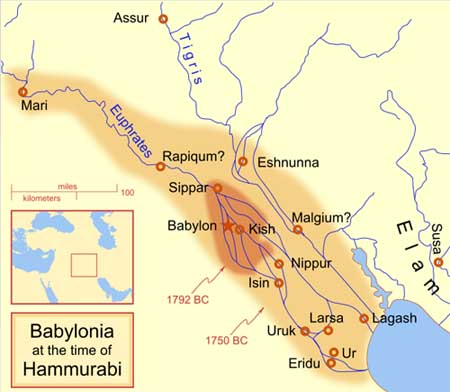 >
>
 >
>
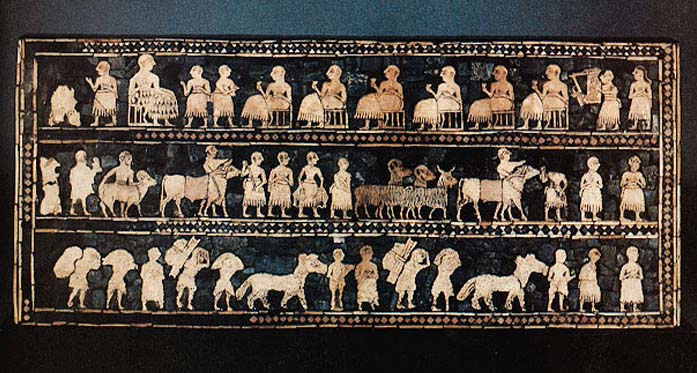
This dynasty is dated to the 25th century BC. En-hegal is recorded as the first known ruler of Lagash, being tributary to Uruk. His successor Lugal-sha-engur was similarly tributary to Mesilim. Following the hegemony of Mesannepada of Ur, Ur-Nanshe succeeded Lugal-sha-engur as the new high priest of Lagash and achieved independence, making himself king. He defeated Ur and captured the king of Umma, Pabilgaltuk. In the ruins of a building attached by him to the temple of Ningirsu, terracotta bas reliefs of the king and his sons have been found, as well as onyx plates and lions' heads in onyx reminiscent of Egyptian work. One inscription states that ships of Dilmun (Bahrain) brought him wood as tribute from foreign lands. He was succeeded by his son Akurgal.
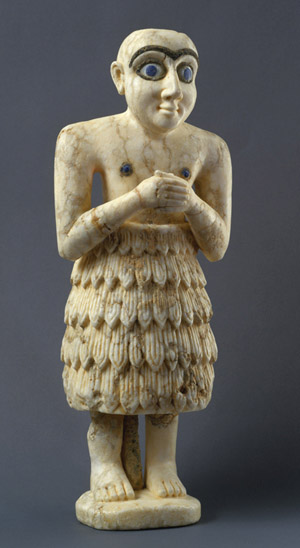
Eannatum
Eannatum, grandson of Ur-Nanshe, made himself master of the whole of the district of Sumer, together with the cities of Uruk (ruled by Enshakushana), Ur, Nippur, Akshak, and Larsa. He also annexed the kingdom of Kish; however, it recovered its independence after his death. Umma was made tributary - a certain amount of grain being levied upon each person in it, that had to be paid into the treasury of the goddess Nina and the god Ningirsu.
Eannatum's campaigns extended beyond the confines of Sumer, and he overran a part of Elam, took the city of Az on the Persian Gulf, and exacted tribute as far as Mari; however many of the realms he conquered were often in revolt. During his reign, temples and palaces were repaired or erected at Lagash and elsewhere; the town of Nina - that probably gave its name to the later Niniveh - was rebuilt, and canals and reservoirs were excavated. Eannatum was succeeded by his brother, En-anna-tum I. During his rule, Umma once more asserted independence under Ur-Lumma, who attacked Lagash unsuccessfully. Ur-Lumma was replaced by a priest-king, Illi, who also attacked Lagash.
His son and successor Entemena restored the prestige of Lagash. Illi of Umma was subdued, with the help of his ally Lugal-kinishe-dudu or Lugal-ure of Uruk, successor to Enshakushana and also on the king-list. Lugal-kinishe-dudu seems to have been the prominent figure at the time, since he also claimed to rule Kish and Ur. A silver vase dedicated by Entemena to his god is now in the Louvre.
A frieze of lions devouring ibexes and deer, incised with great artistic skill, runs round the neck, while the eagle crest of Lagash adorns the globular part. The vase is a proof of the high degree of excellence to which the goldsmith's art had already attained. A vase of calcite, also dedicated by Entemena, has been found at Nippur. After Entemena, a series of weak, corrupt priest-kings is attested for Lagash. The last of these, Urukagina, was known for his judicial, social, and economic reforms, and his may well be the first legal code known to have existed.
Lagashmodern Tell al-Hiba, Dhi Qar Governorate, Iraq) is located northwest of the junction of the Euphrates and Tigris rivers and east of Uruk, about 22 kilometres (14 mi) east of the modern town of Ash Shatrah. Lagash was one of the oldest cities of the Ancient Near East. The ancient site of Surghul/Nina is around 6 miles (9.7 km) away. Nearby Girsu, about 25 km (16 mi) northwest of Al-Hiba, was the religious center of the Lagash state. Lagash's temple was E-Ninnu, dedicated to the god Ningirsu.

From inscriptions found at Girsu such as the Gudea cylinders, it appears that Lagash was an important Sumerian city in the late 3rd millennium BC. It was at that time ruled by independent kings, Ur-Nanshe (24th century BC) and his successors, who were engaged in contests with the Elamites on the east and the kings of "Kiengir and Kish on the north. Some of the earlier works from before the Akkadian conquest are also extremely interesting, in particular Eannatum's Stele of the Vultures and Entemena's great silver vase ornamented with Ningirsu's sacred animal Anzu: a lion-headed eagle with wings outspread, grasping a lion in each talon. With the Akkadian conquest Lagash lost its independence, its ruler or ensi becoming a vassal of Sargon of Akkad and his successors; but Lagash continued to be a city of much importance and above all, a centre of artistic development.
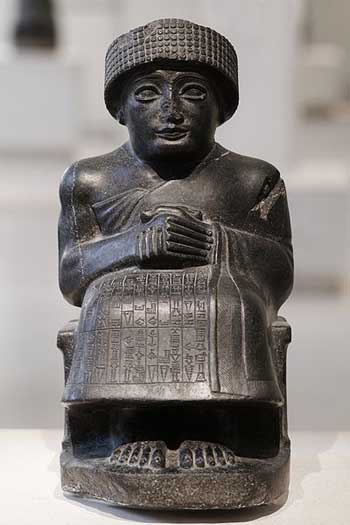
Gudea of Lagash (Louvre)
After the collapse of Sargon's state, Lagash again thrived under its independent kings (ensis), Ur-Bau and Gudea, and had extensive commercial communications with distant realms. According to his own records, Gudea brought cedars from the Amanus and Lebanon mountains in Syria, diorite from eastern Arabia, copper and gold from central and southern Arabia, while his armies were engaged in battles with Elam on the east.
His was especially the era of artistic development. We even have a fairly good idea of what Gudea looked like, since he placed in temples throughout his city numerous statues or idols depicting himself with lifelike realism, (Statues of Gudea). At the time of Gudea, the capital of Lagash was actually in Girsu. The kingdom covered an area of approximately 1,600 square kilometres (620 sq mi). It contained 17 larger cities, eight district capitals, and numerous villages (about 40 known by name). According to one estimate, Lagash was the largest city in the world from ca. 2075 to 2030 BC.
Soon after the time of Gudea, Lagash was absorbed into the Ur III state as one of its prime provinces. There is some information about the area during the Old Babylonian period. After that it seems to have lost its importance; at least we know nothing more about it until the construction of the Seleucid fortress mentioned, when it seems to have become part of the Greek kingdom of Characene.
These dynasties are not found on the Sumerian King List, although one extremely fragmentary supplement has been found in Sumerian, known as the rulers of Lagash. It recounts how after the flood mankind was having difficulty growing food for itself, being dependent solely on rainwater; it further relates that techniques of irrigation and cultivation of barley were then imparted by the gods. At the end of the list is the statement "Written in the school", suggesting this was a scribal school production. A few of the names from the Lagash rulers listed below may be made out, including Ur-Nanshe, "Ane-tum", En-entar-zid, Ur-Ningirsu, Ur-Bau, and Gudea.
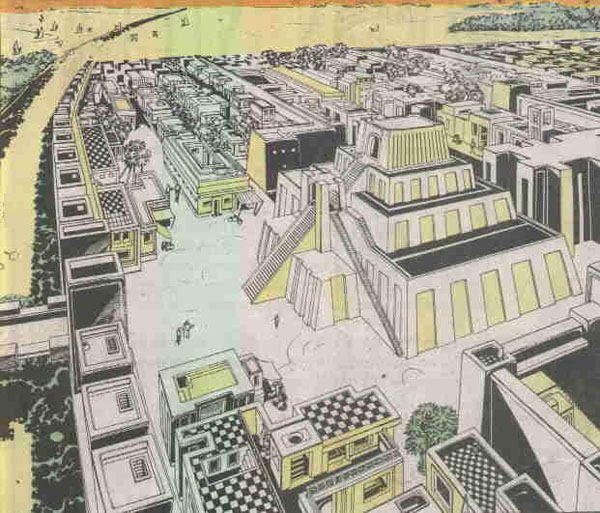

Lagash is one of the largest archaeological mounds in the region, measuring roughly 2 by 1 miles (3.2 by 1.6 km). Estimates of its area range from 400 to 600 hectares (990 to 1,500 acres). The site is divided by the bed of a canal/river, which runs diagonally through the mound. The site was first excavated, for six weeks, by Robert Koldewey in 1887. It was inspected during a survey of the area by Thorkild Jacobsen and Fuad Safar in 1953, finding the first evidence of its identification as Lagash. The major polity in the region of al-Hiba and Tello had formerly been identified as SIR.BUR.LA (Shirpurla).
Tell Al-Hiba was again explored in five seasons of excavation between 1968 and 1976 by a team from the Metropolitan Museum of Art and the Institute of Fine Arts of New York University. The team was led by Vaughn E. Crawford, and included Donald P. Hansen and Robert D. Biggs. The primary focus was the excavation of the temple Ibgal of Inanna and the temple Bagara of Ningirsu, as well as an associated administrative area.
The team returned 12 years later in 1990 for a final season of excavation led by D. P. Hansen. The work primarily involved areas adjacent to an as yet unexcavated temple. The results of this season have apparently not yet been published.